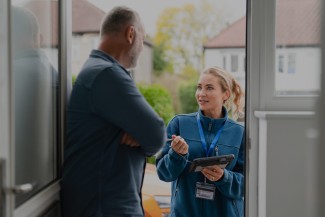Key Findings
|
Comprehensive (i.e., whole-home) energy retrofit projects are complex, expensive, and often disruptive to homeowners and occupants. Retrofits conducted in sequenced stages can appeal to homeowners concerned about the financial burden and inconvenience associated with one-time whole-home energy efficiency and electrification projects. Multistage retrofits allow customers and contractors to develop a sequenced retrofit plan; align projects with equipment and appliance replacement cycles or with the homeowner’s timetable for other home maintenance, upgrades, or remodeling work; and track progress toward their overall objectives.
ACEEE is working with a group of interested market actors including manufacturers, software providers, contractors, and program administrators to explore the feasibility of a market development initiative to support multistage retrofit offerings and build consumer awareness and demand for these offerings. This report summarizes findings from interviews and discussions with each of these stakeholders.
Whole-home retrofit projects deliver a set of measures designed to meet the specific needs of a home using data on baseline energy use, customer input on comfort and other performance issues, and the results of diagnostic testing of air leakage, duct leakage, thermal performance, and potentially other performance issues such as air quality or presence of hazardous materials. Many homeowners will not invest in a full comprehensive home retrofit as one project because of cost, difficulty in finding a contractor who can do all the work, disruption to daily life, confusion about the best course of action, or skepticism about the overall benefits.
A multistage retrofit approach breaks a whole-home retrofit into a series of smaller sequenced projects—the number of stages will vary depending on the number/type of upgrades needed in the home and the interests of the customer. This approach presents the opportunity to respond to customers’ immediate concerns and offer them a stepwise roadmap to complete the retrofit over time. Ideally, the multistage retrofit roadmap is developed shortly after a home energy and performance assessment (i.e., an expanded energy audit) based on discussions with the homeowner about their interests, budget, and other considerations. The roadmap provides the homeowner with a clear vision and a sense of control over the process to achieve their goals.
Efficiency program administrators see multistage retrofits as an opportunity to scale up the number of customers participating in their programs and to achieve deeper savings from each customer by addressing many of the challenges to all-at-once comprehensive home retrofits. To make the most of this opportunity, program administrators, contractors, and stakeholders should collaborate on more formalized and standardized market offerings for multistage retrofits. Key elements of the offering include
- A tailored roadmap developed in collaboration with the homeowner
- Easy-to-use tools that allow homeowners, contractors, and programs to track progress
- Trusted advisors to simplify the process and keep homeowners engaged and motivated
- Robust contractor networks to promote and support cross-trade collaboration
- Flexible measure packages designed to reduce lost energy savings opportunities and avoid lock-in effects
- Appropriate documentation of measures taken and progress toward achieving the roadmap objectives
- Accessible, affordable financing that supports completion of the multistage retrofit
Developing scalable market offerings for multistage retrofits will be complex and challenging. Efficiency programs can help address the challenges by
- Aligning multistage retrofits with program models and goals (e.g., demand reduction, electrification)
- Packaging envelope upgrades with other measures to increase the likelihood envelope improvements are completed
- Increasing program flexibility to support customers over the course of their multistage retrofit project
- Leveraging existing resources and tools (e.g., labeling and certifications, software platforms) to reduce costs, increase consistency
- Supporting contractors with education and training, business development services, incentives, and networking opportunities
- Providing documentation of improved features and energy efficiency (e.g., through certification) to increase their visibility to prospective buyers and lenders at time of home sale or refinance
Policymakers can also play a role in encouraging broader adoption of multistage retrofits. Home energy disclosure policies, including time of sale/listing requirements and building energy passports, have been shown to influence both buyers and sellers to invest in home energy upgrades. Tax credits and other financial incentives can be structured to align with multistage retrofits. Incentives for efficiency and renewable energy systems can be deliberately harmonized. For efficiency programs, regulatory barriers to multistage retrofit programs can be addressed by allowing longer program and budgeting cycles and reconsidering cost-effectiveness approaches to account for multiyear projects. Resale considerations can be systematically integrated into program decisions.
Initial research with contractors and program administrators suggests that multistage retrofits are a promising mechanism for achieving more comprehensive retrofits in homes. Retrofit roadmaps can help homeowners make more informed decisions about the sequence and timing of home retrofit projects to improve outcomes and potentially reduce overall costs. For contractors and program administrators, multistage retrofits provide a platform for increasing the number and depth of projects completed, resulting in expanded business opportunities, program participation, and savings.
Further research and development of the multistage retrofit concept is needed. Important next steps include
- Further engagement with contractors, particularly heating, ventilation, and air conditioning (HVAC) and solar contractors, to inform the development and implementation of more effective ways to expand partnerships across different trades and increase the number of contractors offering critical services including insulation and electrical upgrades
- Consumer research to understand consumer interest in multistage retrofits and the tools, services, and messaging that will resonate with homeowners and encourage them to develop and stick with a multistage retrofit roadmap
- Research on funding mechanisms to support the multistage retrofit process, including guaranteed or reserved incentives, flexible financing tools, innovative mortgage products that support renovations following purchase or that provide home equity lines of credit, and other innovative financing models to reduce risks for consumers and contractors pursuing multistage retrofits
- Further research on the most effective standardized measure packages for different climates and housing types; findings can be used to develop pilot program designs for implementation and evaluation
- Research on the most effective ways to make the enhanced value of improved homes visible throughout the homeownership lifecycle, particularly the home sale and refinance transactions, and the impacts of this enhanced visibility on buyer responses, appraisals, and sale prices
- Research on opportunities and challenges for multistage retrofits in larger multifamily buildings
- Convenings of interested contractors, manufacturers, trade partners, and program administrators to share our findings, gather additional feedback, and engage them in development and implementation of pilot programs
Download the report
| Suggested Citation |
| Amann, Jennifer, and Alex Aquino. 2025. Developing the Market Infrastructure for Multistage Home Retrofits: The Role for Programs. Washington, DC: ACEEE. https://www.aceee.org/research-report/b2507. |




